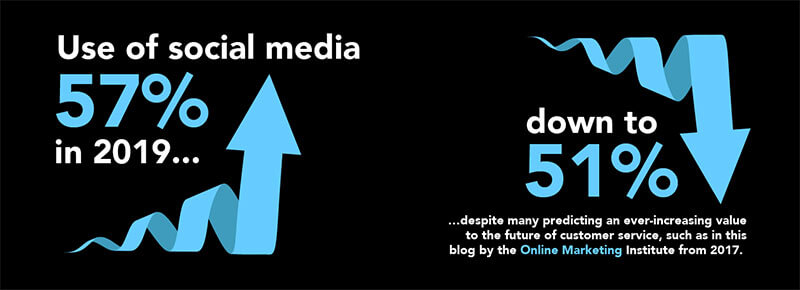Trends in contact centres to 2025: anticipating a focus on automation
We are well on the path towards digital-first interactions.
The speed of advancement in both business and consumer technology means that most contact centre managers seem destined never to feel ready for the future.
The impact of technological diffusion over the past several years has been most evident through the ongoing, successful adoption of digital channels. Voice traffic is now about 62% of the total, down from 90% in 2006 as email, self-help and webchat have each grown to take a more prominent share. Company websites are, meanwhile, more able to mitigate the need for customer communication per se. For instance, online portals, such as booking forms and pricing tools often address customer queries and proactive order tracking applications stop customers having to chase progress.
The UK customer satisfaction index shows that the highest satisfaction scores across different ways of interacting with a business are achieved through digital channels, with some form of app use being highest of all, reflecting that time and effort are a significant driver of customer perceptions now that smart phones are pervasive.

Different communication channels represent different ‘value propositions’ to consumers who might be needing information from their service provider or wanting to notify of a change to their product or report a fault. Chat is valuable when seeking a fast resolution to a query, email is good when the issue is more complex but not time-sensitive, and voice remains the best option for interactions where there is some ambiguity over the customer’s need and a higher level of personalisation is sought. It can also depend whether the consumer is: on the sofa, on the train, or in the office on a coffee break.
Smart phones make it easy to use any number of communication channels with a swipe and a touch. However, within the contact centre itself, most digital channels, including social media, have been run using standalone systems to the one used for voice calls.
Therefore, for many customers, the benefits of digital are already being realised through the greater convenience offered when trying to communicate with a company and speed in finding a resolution. These days, customer experiences go horribly wrong more often through the lack of joined-up processes and systems at the back end rather than a lack of available ways of contacting an organisation.
Slick digital experiences often believe the contact centre reality
On the contact centre side of the relationship however, challenges and battles persist. While the technology world talks about omnichannel experiences, AI, robotics, IOT and virtual reality, the present reality within the contact centre is still that only around 1 in 4 UK contact centres are omni-channel. Most are also still relying on manual processes while supervisors and managers extract data and use spreadsheets for analysis, planning and forecasting.
Call centre managers and agents continue to report working in challenging environments, leading to high agent churn rates and elevated levels of employee dissatisfaction. Managers often believe that their business set unrealistic metrics and expectations, particularly as they battle with sub-optimal technology, and the shifting norms around hybrid working that followed COVID.
As costs rise and the economy brings the prospect of a protracted downturn, there is understandably a reluctance to invest and so the contact centre challenges can become exasperating.

With prioritisation required, thoughts might turn to the dilemma of which problem has most value in tackling next:
The argument for automation might soon grow louder
Digital channels are working well and are on a positive trajectory to enhance customer experiences further and can be cheaper on a per-transaction basis compared to voice calls. However, Contact Babel have made the point that they are not as cheap as they might be compared to if they were powered by automation, rather than continuing to rely on agents. As businesses seek cost savings, this alone might drive a heightened focus.
The reason that businesses have not done more to drive ROI from digital migration is because, until now, the main driver has been the customer experience rather than the cost-to-serve. Digital channels are cheaper than voice, so the focus has been on retaining competitiveness as the consumer expects to be able to use digital and voice channels interchangeably.
Implementing an omnichannel experience has now been the #1 investment aspiration for contact centre decision makers for 8 consecutive years according to Contact Babel’s 2023 CX Decision-Makers Guide, as a failure to offer this will represent obsolescence for many service providers. Motives are to ensure that customers’ experiences meet expectations, and that the organisation retains a single view of the customer. Both are becoming a near defacto standard of modern customer experiences for medium and larger businesses, so we do not expect this drive to stop, despite economic conditions.
However, with that economic situation changing, we might also expect a reinvigorated focus on automation due to acute cost pressures as well as the acute difficulty in finding new agents.
The attraction of automation to a company is that in offering capability to make inroads into many areas of expenditure, it achieves multiple goals. Facets of the contact centre that are open to automation run right across the customer journey and beyond, from routing calls, to handling them, storing information, triggering tickets or actions, analysing data, and providing a follow-up with the same customer sometime later. The sources of expenditure that can be reduced include lowering call centre staffing and recruitment costs, reducing wrap-times and time spent on other process administration, as well as reducing the costs of errors. Automation provides a real time source of data capture and analytics that inform and importantly highlight what is happening in the Contact centre and how it’s affecting customer experience.
Also, unlike a few years ago, the precedent has been set by a body of early adopters of automation, to give others confidence that it works and generates value. For instance, the number of contact centres using virtual assistants increased by over 10% YOY in 2022, after doubling the previous year (Contact Centre Helper). Self-service has recently been voted as the technology delivering the best value for money in Contact Centre Helper’s latest UK industry survey (Contact Centre Helper).
While automation has not, to date, been the #1 requirement, we also see that contact centre decision makers will adapt their focus and investments in the face of evolving challenges. For instance, in the last 2021 Contact Center Helper annual industry survey, agent gamification, heralded as the solution for wavering employee engagement and to incentivise high-performing agents not so long ago, had declined in use to 24%. This is less than half the number using it in 2016.

In the US, the contact centre market is slightly advanced on the UK in terms of technology adoption. A recent study by one vendor found that 80% of contact centres were current evaluating automation solutions for 2023, in the face of cost pressures and recruitment challenges.
If there is a downturn, TelXL are ready to help
Many smaller and medium sized businesses have already said that they expect for growth and recruitment to be slowed with the economy taking a downturn (e.g., SME Insight Report 2022). If businesses want to continue to grow their top line, therefore, they must look toward productivity and efficiency benefits.
Therefore, when we look ahead to what contact centres might over in the next few years, while the current trends toward omnichannel and conversational AI will certainly continue, and we might see disruptive leftfield trends through new social channels or virtual reality, TelXL are readying ourselves for the picture painted by those economic forecasts forecasting a period of downturn.
If that materialises, then with an offering that delivers benefits of automation, we are equipped to help with most acute commercial and strategic challenges that SMEs are going to be facing in the upcoming period. What COVID did for Teams and collaboration tools, a protracted recession might well do for automation.



